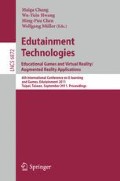Abstract
In hopes of finding an appropriate way to integrate virtual worlds into Computer Assisted Language Learning (CALL), this paper introduces a 3D virtual platform for language education set up by OpenSimulator and Moodle. The resulting 3D virtual world can not only create a graphic immersive context for students to practice language use, but also offer teachers a better management tool to keep student records and teaching content. Furthermore, some teaching aids and learning tools are developed to support language learning and teaching, and three types of task-based instructional activities are designed to offer an appropriate, appealing and meaningful context where the target language can be acquired naturally with less anxiety. We hope that the 3D virtual world can be an option for the English classroom to provide students an input-rich and immersive environment where learning can be fun.
Access this chapter
Tax calculation will be finalised at checkout
Purchases are for personal use only
Preview
Unable to display preview. Download preview PDF.
References
Littlewood, W.: Communicative Language Teaching. Cambridge University Press, New York (1981)
Sullivan, P.: Practicing Safe Visual Rhetoric on the World Wide Web. Computers and Composition 18, 103–121 (2000)
Minocha, S., Reeves, A.: Designing Learning Activities in Second Life for Student Engagement. In: The 4th and FINAL Open CETL Conference, The CETLs: Celebrating Teaching and Learning, pp. 15–16. The Open University, Milton Keynes (2009)
Henderson, M., Huang, H., Grant, S., Henderson, L.: Language Acquisition in Second Life: Improving Self-efficacy Beliefs. In: Proceedings Ascilite Auckland 2009, pp. 463–473 (2009)
Toyoda, E., Harrison, R.: Categorization of Text Chat Communication Between Learners and Native Speakers of Japanese. Language Learning and Technology 6(1), 82–99 (2002)
Peterson, M.: Learning Interaction in an Avatar-based Virtual Environment: A Preliminary Study. PacCALL Journal 1(1), 29–40 (2005)
Molka-Danielsen, J., Richardson, D., Deutschmann, M., Carter, B.: Teaching Languages in a Virtual World. In: Proceedings of NOKOBIT, pp. 97–109. Tapir Akademisk Forlag, Oslo (2007)
Hislope, K.: Language Learning in a Virtual World. The International Journal of Learning 15(11), 51–58 (2008)
Deutschmann, M., Panichi, L.: Talking into Empty Space? Signaling Involvement in a Virtual Language Classroom in Second Life. Language Awareness 18(3-4), 310–328 (2009)
Wang, C., Song, H., Stone, D.E., Yan, Q.: Integrating Second Life into an EFL Program in China: Research Collaboration Across the Continents. TechTrends 53(6), 14–19 (2009)
Peterson, M.: Learner Participation Patterns and Strategy Use in Second Life: an Exploratory Case Study. ReCALL 22(3), 273–292 (2010)
Andreas, K., Thrasyvoulos, T., Stavros, D., Andreas, P.: Collaborative Learning in OpenSim by Utilizing SLoodle. In: 2010 Sixth Advanced International Conference on Telecommunications, pp. 90–95 (2010)
Livingstone, D., Kemp, J.: Integrating Web-based and 3D Learning Environments: Second Life Meets Moodle. The European J. for the Informatics Professional 9(3), 8–14 (2008)
Shih, Y.-C., Yang, M.-T.: A Collaborative Virtual Environment for Situated Language Learning Using VEC3D. Educational Technology & Society 11(1), 56–68 (2008)
Vickers, H.: VirtualQuests: Dialogic Language Learning with 3D Virtual Worlds. CORELL: Computer Resources for Language Learning 3, 75–81 (2010)
Jung, H.J.: Virtual Reality for ESL Students. The Internet TESL Journal 8(10) (2002)
Author information
Authors and Affiliations
Editor information
Editors and Affiliations
Rights and permissions
Copyright information
© 2011 Springer-Verlag Berlin Heidelberg
About this paper
Cite this paper
Chen, HJ., Su, CC. (2011). Constructing a 3D Virtual World for Foreign Language Learning Based on Open Source Freeware. In: Chang, M., Hwang, WY., Chen, MP., Müller, W. (eds) Edutainment Technologies. Educational Games and Virtual Reality/Augmented Reality Applications. Edutainment 2011. Lecture Notes in Computer Science, vol 6872. Springer, Berlin, Heidelberg. https://doi.org/10.1007/978-3-642-23456-9_10
Download citation
DOI: https://doi.org/10.1007/978-3-642-23456-9_10
Publisher Name: Springer, Berlin, Heidelberg
Print ISBN: 978-3-642-23455-2
Online ISBN: 978-3-642-23456-9
eBook Packages: Computer ScienceComputer Science (R0)

